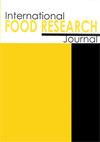Nutritional content and quality of processed gluten-free products
IF 1
4区 农林科学
Q4 FOOD SCIENCE & TECHNOLOGY
引用次数: 0
Abstract
The present work aimed to compare the macro- and micronutrient contents of gluten-free (GF) and gluten-containing (GC) products from a wide range of stores in Jeddah, Saudi Arabia. A case-control study was conducted. Twelve major supermarkets in Jeddah, Saudi Arabia were visited, and the nutritional information labels of 92 GF and 46 GC products were compared. Results showed that GF products were significantly lower in protein (p = 0.004), total sugar (p = 0.01), calcium (p = 0.02), iron (p = 0.002), and vitamin D (p = 0.01) than GC products. Furthermore, GF breads, flours, and pastas had significantly lower amounts of protein than their GC counterparts (p < 0.001, p = 0.03, and p < 0.001, respectively). Fibre was significantly higher in GF than GC biscuits and breads (p = 0.04 and p = 0.01, respectively). However, GF pastas had significantly lower content of fibre per 100 g than GC pastas (p = 0.02). Overall, the nutritional quality of GF products was not significantly different from GC products. Although GF and GC biscuits and cookies were considered low nutritional value products, the nutritional quality scores of GF biscuits and cookies were significantly higher than their GC counterparts. GF products were lower in protein, total sugar, vitamin D, calcium, and iron than GC products. The nutritional quality of GF products did not differ from GC products. Food manufacturers should pay more attention to the nutritional content of GF products. Future studies are needed for the nutritional assessment of GF products, and how nutritional content may influence the diet quality of individuals with celiac disease who follow gluten-free diets.加工无麸质产品的营养成分和质量
本研究旨在比较沙特阿拉伯吉达大量商店中无谷蛋白(GF)和含谷蛋白(GC)产品的宏量营养素和微量营养素含量。进行了病例对照研究。走访了沙特阿拉伯吉达的12家主要超市,比较了92种GF产品和46种GC产品的营养信息标签。结果表明,GF产品的蛋白质(p = 0.004)、总糖(p = 0.01)、钙(p = 0.02)、铁(p = 0.002)和维生素D (p = 0.01)含量显著低于GC产品。此外,无糖面包、面粉和面食的蛋白质含量明显低于无糖面包(p <0.001, p = 0.03, p <分别为0.001)。GF中纤维含量显著高于GC饼干和面包(p = 0.04和p = 0.01)。然而,GF面食每100 g纤维含量显著低于GC面食(p = 0.02)。总体而言,GF产品的营养品质与GC产品没有显著差异。虽然GF和GC饼干和饼干被认为是低营养价值产品,但GF饼干和饼干的营养质量得分明显高于GC饼干和饼干。GF产品的蛋白质、总糖、维生素D、钙和铁含量低于GC产品。GF产品的营养品质与GC产品无显著差异。食品制造商应更加关注GF产品的营养成分。未来的研究需要对无谷蛋白产品的营养评估,以及营养成分如何影响遵循无谷蛋白饮食的乳糜泻患者的饮食质量。
本文章由计算机程序翻译,如有差异,请以英文原文为准。
求助全文
约1分钟内获得全文
求助全文
来源期刊

international food research journal
Agricultural and Biological Sciences-Food Science
CiteScore
1.40
自引率
0.00%
发文量
75
期刊介绍:
The International Food Research Journal (IFRJ) publishes papers in English, six (6) issues a year with the coverage of:
Food Science and Technology
Nutrition and Dietetics
Agriculture, multidisciplinary
Chemistry, multidisciplinary
The scope of the Journal includes:
Food Science, Food Technology and Food Biotechnology
Product Development and Sensory Evaluation
Food Habits, Nutrition, and Health
Food Safety and Quality
Food Chemistry, Food Microbiology, Food Analysis and Testing
Food Engineering
Food Packaging
Food Waste Management
Food Entrepreneur
Food Regulatory
Post-Harvest Food Management
Food Supply Chain Management
Halal Food and Management
 求助内容:
求助内容: 应助结果提醒方式:
应助结果提醒方式:


